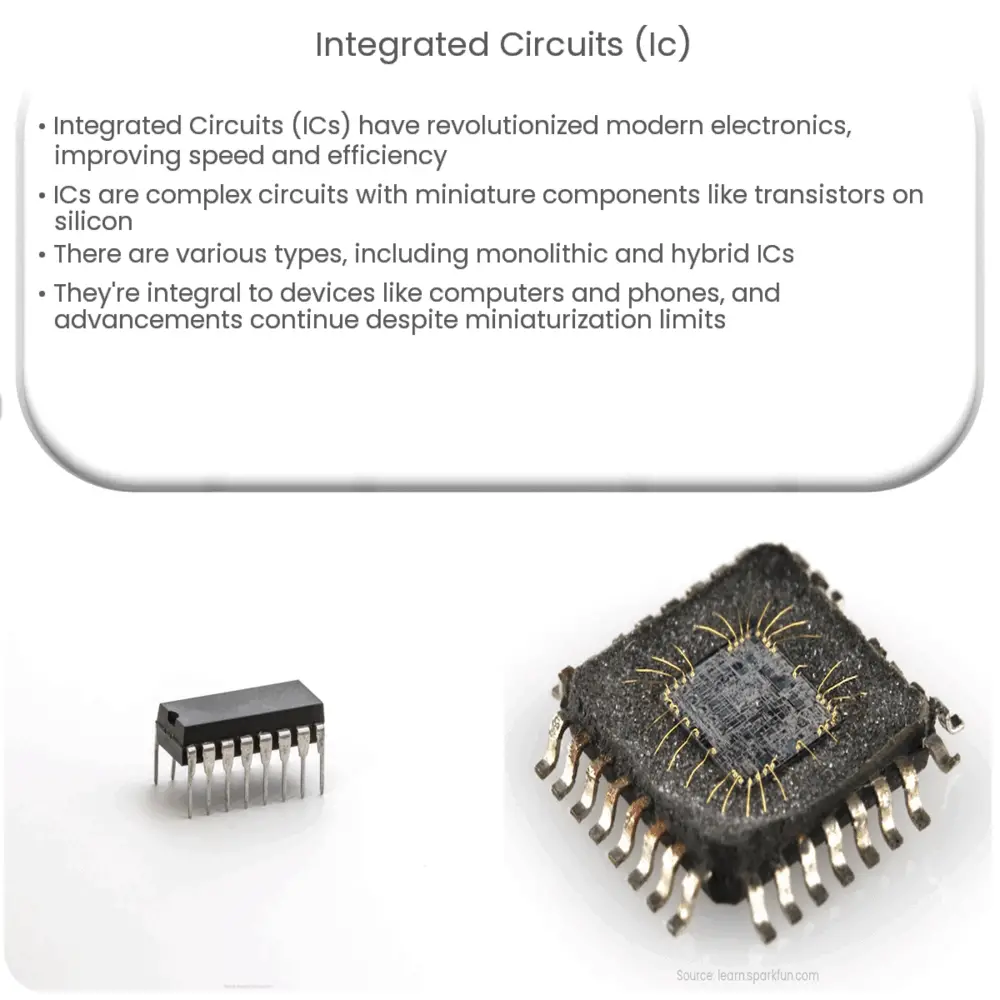Explore the fascinating world of Integrated Circuits (ICs), their types, manufacturing, applications, impact, future, and limitations in this detailed guide.

Introduction to Integrated Circuits (IC)
Integrated Circuits (ICs), often referred to as chips or microchips, play a pivotal role in modern electronics. They have revolutionized technology and have dramatically increased the speed and efficiency of electronic devices.
What are Integrated Circuits?
An Integrated Circuit is a tiny complex electronic circuit consisting of several miniature electronic components such as transistors, capacitors, and resistors. These components are etched or imprinted onto a semiconducting material, usually silicon. The integration of a large number of tiny transistors into a small chip was a massive step forward in the electronics industry, replacing the manual assembly of circuits using discrete electronic components.
Types of Integrated Circuits
- Monolithic Integrated Circuits: This is the most common type of IC where all components and the chip are created on a single semiconductor wafer. It is used in almost all modern electronics including computers, mobile phones, and digital microwave ovens.
- Hybrid Integrated Circuits: These are ICs that use a combination of monolithic ICs, discrete components, and film components on a single ceramic substrate. They are often used in power devices and microwave systems.
How are Integrated Circuits Made?
The manufacturing process of ICs is a fascinating blend of science and technology. It starts with the production of a silicon wafer, a thin slice of crystalline silicon. The silicon wafer is then subjected to a process known as photolithography, which uses light to transfer a geometric pattern from a photomask to a light-sensitive chemical called photoresist, applied on the substrate.
Applications of Integrated Circuits
The application of ICs is vast and they play an integral part in the functioning of modern digital electronics. Here are a few main applications:
- Computers: ICs are the heart of computers. Every computer consists of a central processing unit (CPU), which is made up of ICs.
- Mobile Devices: Mobile phones, tablets, and other mobile devices rely on ICs for a variety of functions including processing, memory, and power management.
More Applications of Integrated Circuits
- Consumer Electronics: From televisions and radios to kitchen appliances and game consoles, ICs are ubiquitous in consumer electronics, helping to improve functionality and reduce cost.
- Automobiles: Modern cars are filled with ICs, controlling everything from fuel injection and antilock brakes to climate control systems and in-car entertainment systems.
- Healthcare: Integrated Circuits have revolutionized medical technology. They’re used in various medical devices such as pacemakers, MRI machines, hearing aids, and many others.
The Impact of Integrated Circuits
ICs have had a tremendous impact on our lives and society at large. They have facilitated the miniaturization of electronic devices, leading to the development of small, portable, and highly versatile digital devices. This development has played a key role in the digital revolution, enabling advances in computing, communications, and a wide range of other areas.
Future of Integrated Circuits
With technology advancing rapidly, the future of ICs holds immense potential. New materials such as graphene are being explored for use in ICs, and researchers are continually seeking ways to increase circuit density, enabling even more powerful and efficient chips.
The Limitations of Integrated Circuits
Despite the numerous advantages and advancements, ICs do have their limitations. The most notable one being the physical limits of miniaturization, often referred to as Moore’s Law, which predicts the doubling of transistors on a chip approximately every two years. As transistors approach the size of atoms, this trend cannot continue indefinitely. However, novel technologies such as quantum computing may provide potential solutions to these limitations.
Conclusion
In conclusion, Integrated Circuits are a cornerstone of modern electronics. They have enabled the digital revolution, reshaping our society and daily lives. Despite certain limitations, continuous research and development in this field promise an exciting future for ICs. As we look forward to innovations like quantum computing and advanced materials, we can expect ICs to continue playing a vital role in technological advancement.

